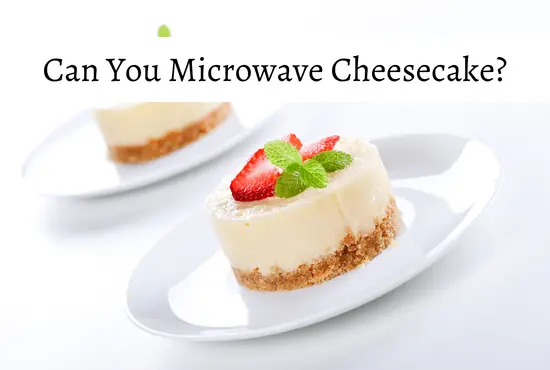While cheesecake makes the perfect summer dessert with layers of goodness, maintaining its consistency cannot be easy. It is especially the case when you freeze the leftover slices and later feel the urge to eat them.
What should you do then? Is it a good idea to microwave cheesecake?
You can microwave frozen cheesecake as it is not only safe to do but also time-saving. However, avoid putting the whole dessert in the microwave; rather, it is much more effective to reheat sliced cheesecake as it will thaw evenly. Just place it on a microwavable dish, and it’s ready to serve in a few seconds.
Did you know that during the pandemic, there was a rise in the consumption of comfort food and cheesecake was among them? After all, all you need is some easily-at-home ingredients, and you can create one. Let’s learn today how you can effectively microwave it and the precautions to take.
Table of Contents
Can You Microwave Frozen Cheesecake?
Cheesecake is a tasty sweet dessert that instantly lights up any dining table. But, to enjoy its super rich and creamy texture, the goal is to serve it in the best condition possible. Normally, cheesecake lovers vouch for it to be at room temperature. It’s fine, but what about the situation when you have a frozen cheesecake at hand?
When it comes to reheating, it is safe and convenient to microwave cheesecake- it’s ready for serving in a couple of minutes. However, you need to plan ahead when defrosting this delightful dessert.
Either homemade or store-bought cheesecake must be stored in the fridge or freezer to avoid contamination or bacterial activity; this ensures it is ready for reheating. Secondly, instead of popping the whole cake inside the microwave, put individual slices in the microwave, where it will take only 30-50 seconds to thaw nicely and evenly.
Following the right microwaving process will give you a perfect cheesecake texture and consistency. Enjoy this appetizing dessert with friends or family, and call it a day!
Can You Microwave Cheesecake Factory Containers?
Cheesecake factory containers are recyclable as well as microwavable, so you can, without any trouble, slide them into the microwave and heat the components inside. These ‘takeout’ boxes or containers are designed to withstand the high heat of the microwave and are real game changers.
With cheesecake factory containers, you don’t have to worry about first arranging a microwave-safe plate or container and then reheating your favorite dessert. It can turn into a real-time hassle, especially when you can no longer hold your hunger!
However, if you stored the leftover cheesecake slices in some other box/container, you would have to ensure that it is microwave-friendly or not. Usually, the containers labeled with an imprinted microwave symbol are good to go inside the microwave. Without one, you would have to transfer your dessert pieces to a microwave-safe plate/container.
How To Quickly Reheat Cheesecake In The Microwave?
Wonder how you can microwave cheesecake without losing its smooth, creamy texture? Guess no more, as the step-by-step process below will help you get your desired results within seconds. So, let’s go through the steps!
- Dessert experts recommend not putting the whole cheesecake in the microwave because it won’t thaw evenly.
- Microwaving works best when you plan to defrost your cheesecake slices quickly and effortlessly.
- First, remove all the storage wrapping- foil and plastic wrap- to thaw this tasty dessert in the microwave.
- For best results, put one or two slices on the microwave-friendly dish at a time, and avoid over-stuffing the dish with multiple slices. It will ensure even heating.
- Heat the cheesecake slices for around 30 seconds and repeat the same process with the remaining slices.
- Once thawing is complete, allow the cheesecake slices to sit for a while before final serving. Enjoy!
How Long Is Cheesecake Good For In The Microwave?
The amount of time that goes into warming up a cheesecake depends on different factors, such as size and thickness. Talking of size, slices of cheesecake defrost way quicker in comparison to whole cakes. With whole cakes, you have different size variations, some consisting of multiple layers, ingredients, and much more.
Similarly, thicker and denser cheesecakes will take much longer to defrost evenly in the microwave than lighter ones. Generally, it takes less than 60 seconds for cheesecake slices to thaw in the microwave, but depending on the size and thickness, you might have to run them a few times through the machine.
Nonetheless, suppose you want your cheesecake to heat up in the best possible way. In that case, it is suggested to let it sit in the refrigerator overnight- this way, you will get a hundred percent fully thawed dessert, regardless of thickness, size, or density. But if you can’t wait this long, you can opt for the microwave option.
Safety Tips To Consider Before Reheating Cheesecake
At this point, it’s already clear enough that microwaving cheesecake helps when you want quickly and effortlessly to heat this mouthwatering dessert. But, there are a few precautionary tips you must be well aware of.
- Firstly, before popping your cheesecake inside the microwave, ensure it is stored properly- in a fridge or freezer in proper safety packaging.
- In case of improper storage- there are high chances of bacterial growth and freezer burns- microwaving later might not be the safest idea.
- As the food reaches a high internal temperature in the microwave, turning into an ideal breeding ground for bacteria. And consuming such food can make you sick. Why risk it?
- Similarly, if you let the cheesecake sit at room temperature for more than two hours, you should drop the idea of microwaving it.
- Always use a microwave-safe dish or plate to heat your cheesecake slices- in the case of ‘takeout’ containers, you can heat the dessert directly.
All these safety tips align with the guidelines given by the FDA, so make sure to follow them to prevent any risky situation.



